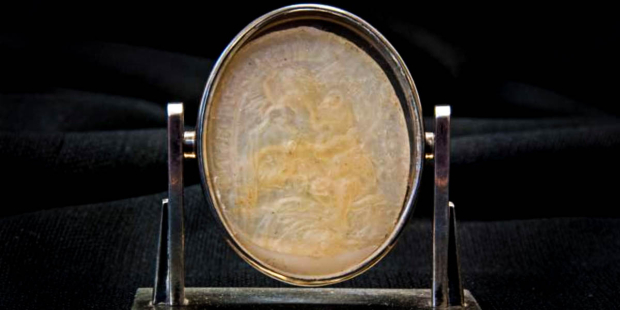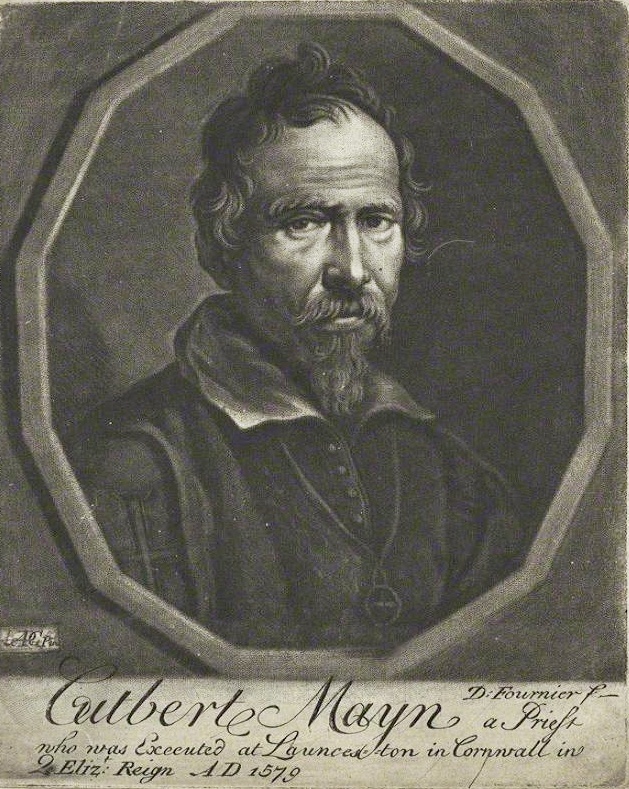
When Mayne was born, King Henry VIII, who had broken England’s communion with the Holy Father in 1535. His son and successor, Edward VI (1547-1553), had persisted in the schism. Edward’s successor was his Catholic sister Mary (1553-1558), who restored England to the Catholic Church. Mary’s death, however, ended the prospects of a Catholic England. At the beginning of her reign, her sister Queen Elizabeth I (1558-1603), a Protestant, reversed Mary’s restoration of Catholicism. The Act of Supremacy of 1558 had reestablished Elizabeth as head of the English church, and the Act of Uniformity of 1559 had made Archbishop Cranmer’s Book of Common Prayer the only lawful liturgical book in England. Like her father Henry VIII, Elizabeth brooked little opposition. Catholic priests who had been educated and ordained at William Allen’s seminary for English priests at Douai, in Belgium, particularly incensed her regime. Priests who had been in the country during the reign of Mary (1553-1558) were grudgingly permitted their lives; émigré priests, however, were hunted down and disembowelled.
The religious reign of terror of the regime forced the vast majority of Englishmen, Catholic though they were in their religious preferences, to conform to the “Elizabethan Religious Settlement.” Pockets of Catholics nonetheless soldiered on. As the scholarship of Eamon Duffy shows very clearly, Cuthbert Mayne’s native shire of Devon was particularly loyal to Catholic Christianity. Mayne was raised by an uncle, a priest who had conformed to Anglicanism. Mayne was likewise ordained a priest of the Anglican Church at about eighteen years of age. After ordination, he studied at Oxford University. By 1570, Mayne had received a Master of Arts degree, and in the meantime made the acquaintance of Edmund Campion, a Jesuit. Campion and other Catholics at Oxford had made a deep impression on Mayne, who came to believe in the truth of Catholic Christianity.
From the new seminary for English Catholic priests at Douai, in Belgium, Campion wrote and encouraged Mayne to emigrate and study there for the priesthood. In 1573, Mayne was formally received into the Catholic Church, and became a seminarian. By 1576 he was ordained, and became the fifteenth of the Douai priests to return to England.

-Golden Manor house, Cornwall, UK, ancestral home of Francis Tregian
A Catholic estate-owner by the name of Francis Tregian accepted Mayne as a member of his household. Mayne served outwardly as Tregian’s steward, while secretly ministering as priest. Protestant locals must have grown suspicious and reported the possibility of a Catholic priest in Tregian’s household to the authorities, and pursuivants, as Elizabeth’s secret religious police were known, arrested Mayne for having a copy of the Agnus dei written on a parchment he wore around his neck. Late medieval English Catholics often wore prayers around the neck, as protection against sin and misfortune, a practice Protestants despised as superstition.
The conditions of Mayne’s imprisonment were appalling. Since the case against him was weak, prosecutors were in no hurry to file formal charges against him. In the end, was indicted for “crimes” he had committed while a prisoner. The government accused Mayne of advocating for the papal supremacy among his fellow prisoners, and of having celebrated the Mass in his cell.
While awaiting trial at the circuit assizes in September, Mayne was imprisoned in Launceston Castle. At the opening of the trial on 23 September 1577 there were five counts against him: first, that he had obtained from the Roman See a “faculty” (or bulla), in violation of, the Statute of Praemunire and 13 Elzabeth I, c. 2, making it treason punishable by death to bring into England papal bulls, to possess them, or promulgate them, such as the one in the possession of Cuthbert Mayne containing absolution of the Queen’s subjects; second, that he had published the same at Golden Manor, ancestral home of his friend, host, protector, and benefactor, Francis Tregian, one of the wealthiest men in Cornwall; third, that he had taught the ecclesiastical authority of the pope and denied the queen’s ecclesiastical supremacy while in prison, a violation of 5 Elizabeth I, c. 1, against maintaining and defending the authority and the power of the Bishop of Rome in print, writing, words, or deed ‘making it treasonable to: maliciously, advisedly, and directly publish, declare, hold opinion, affirm or say by any speech express words or saying, that our said sovereign lady Queen Elizabeth during her life is not nor ought not to be Queen of this realm of England and also of the realms of France and Ireland; or that any other person or persons ought of right to be King or Queen of the said being under her Majesty’s obeisance…it also being treason to call the monarch a heretic, schismatic, infidel, or usurper.’ , and 23 Elizabeth I, c. 1, ‘That all persons whatsoever, which have or shall have, or shall pretend to have Power, or shall by any Ways or Means put in Practice to absolve, persuade or withdraw any of the Queen’s Majesty’s Subjects, or any within her Highness Realms or Dominions, from the their Natural Obedience to her Majesty: (2), Or to withdraw them from that Intent from the Religion now by her Highness Authority established within her Highness Dominions, to the Romish Religion, (3) or to move them or any of them to promise and Obedience to any pretended Authority of the See of Rome, or to any other Prince, State or Potentate, to be had or used within her Dominions, (4) or shall do any overt Act to the Intent or Purpose; and every of the shall be to all Intents adjudged to be Traytors, and being thereof lawfully convicted shal have Judgement, suffer and forfeit, as in Case of High Treason.’; fourth, that he had brought into the kingdom an Agnus Dei (a Lamb of God sealed upon a piece of wax from the Paschal candle blessed by the pope) and delivered it to Francis Tregian; fifth, that he had celebrated Mass.
Mayne answered all counts. On the first and second counts, he said that the supposed “faculty” was merely a copy printed at Douai of an announcement of the Jubilee of 1575, and that its application having expired with the end of the jubilee, he certainly had not published it either at Golden (the manor house of Francis Tregian) or elsewhere. On the third count, he said that he had asserted nothing definite on the subject to the three illiterate witnesses who swore to the contrary. On the fourth count, he said that the fact he was wearing an Agnus Dei at the time of his arrest did not establish that he had brought it into the kingdom or delivered it to Tregian. On the fifth count, he said that the presence of a Missal, a chalice, and vestments in his room did not establish that he had said Mass.
Irregularities of procedure plagued the case against Mayne, but the government was determined to take his life, and the court condemned him to death. Mayne responded, “Deo gratias!”
The day before his execution, the government offered to spare his life in exchange for acknowledgement of the queen’s supremacy and renouncing Roman Catholicism, by testifying against Tregian and revealing other Catholics. Declining both offers, he kissed a copy of the Bible, declaring that, “the queen neither ever was, nor is, nor ever shall be, the head of the church of England”
The following day, Mayne was hanged for about one minute, cut down still alive, most sources say unconscious since his head had hit the scaffolding with such a force it knocked his eyeballs from their sockets, and butchered. Pope Paul VI canonized him in 1970. No one whom Mayne, the first of the Elizabethan priest-martyrs, received into the Catholic Church ever relapsed. Not even persecution could rob his ministry of its fruits. He was the first seminary, as opposed to religious order priest, or proto-martyr, for secular/seminary priests to be martyred in England.
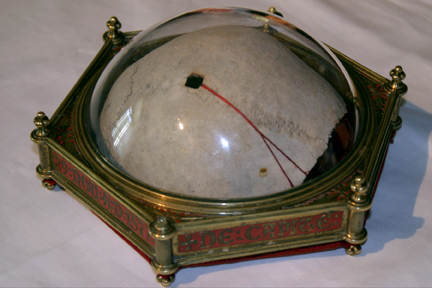
-skull of St Cuthbert Mayne, Carmelite Convent, Lanherne, Cornwall, UK
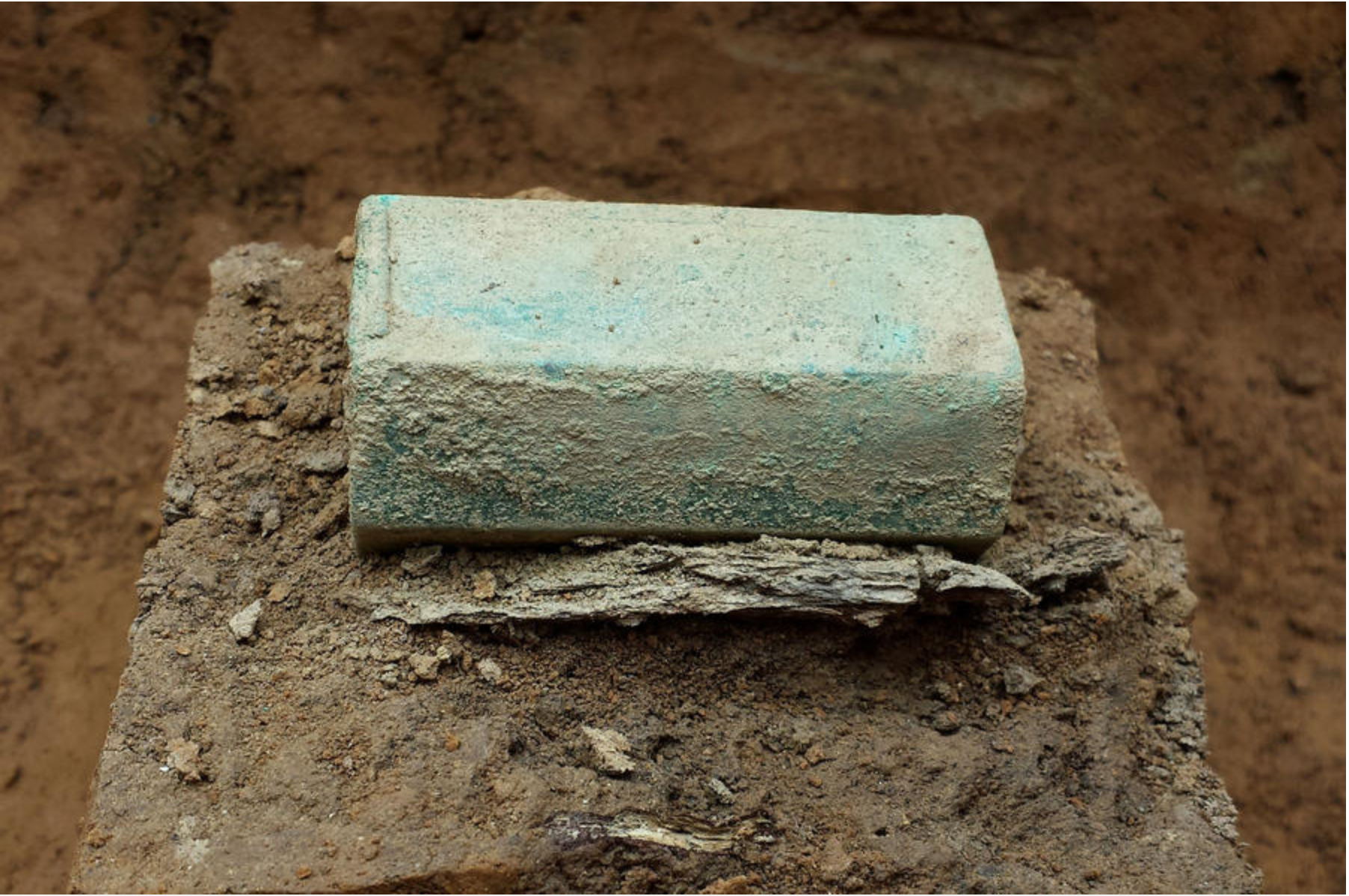
-reliquary of St Cuthbert Mayne in situ, sitting above the coffin detritus in the grave identified as that of Captain Gabriel Archer, Jamestown, Virginia, USA. In the harsh winter of 1609-1610, settlers at Jamestown placed a small silver case with a slide opening etched with a single letter ─ M ─ carefully on top of a white oak coffin and then covered it with the hard, cold dirt of the New World. Inside the silver encasing were seven bone fragments and two lead ampulae filled with water, oil, dirt, or blood.
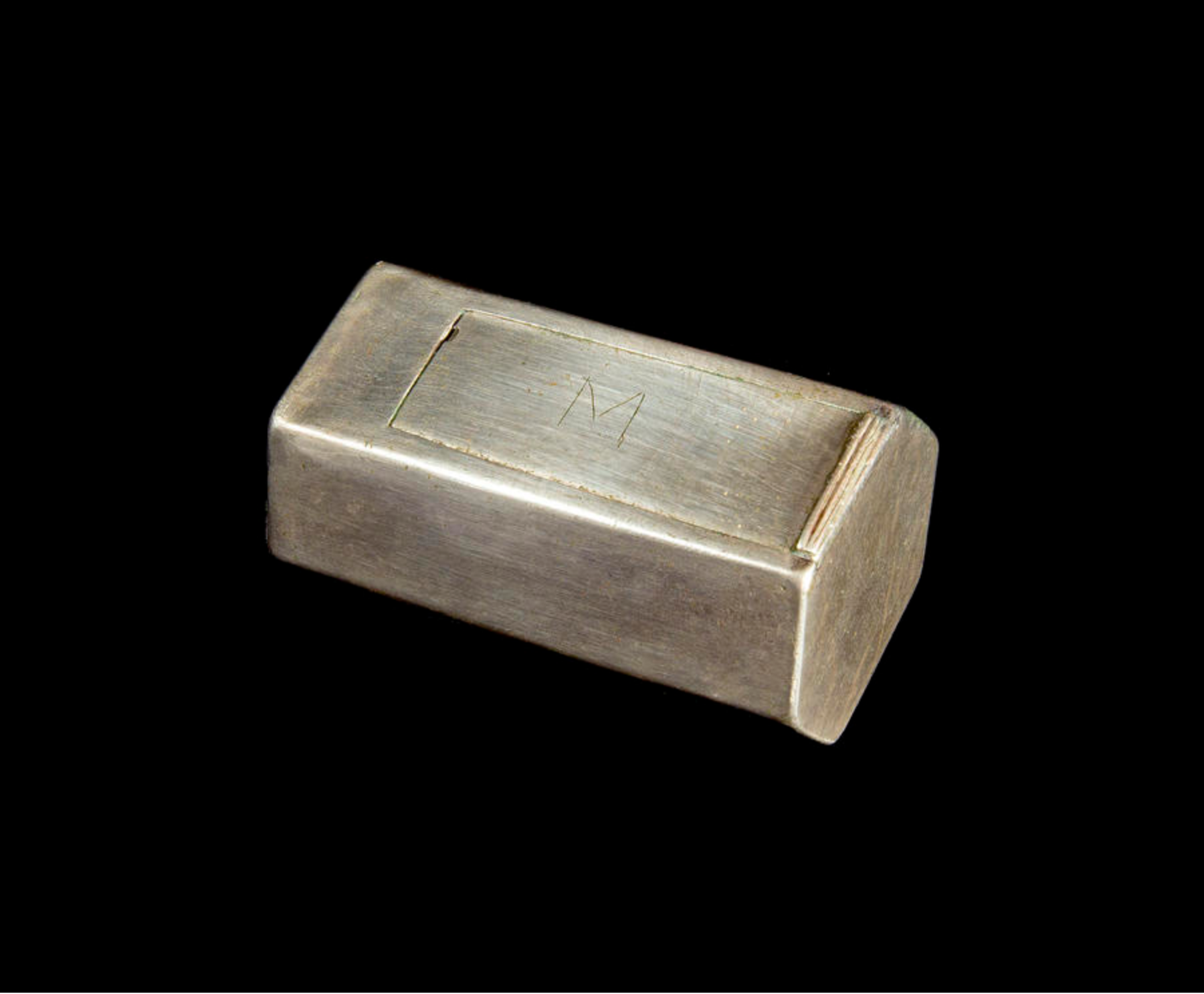
-reliquary after preservation. The fine silver work of the hexagonal tube is juxtaposed with the crudely made M, scratched on the slide opening.
“Holding the reliquary in the palm of one’s hand is instructive. It is small, measuring just under three inches in length and an inch and a half in diameter. Conservators at Jamestowne Rediscovery have meticulously restored it, freeing its silver encasement of the green oxidation from sitting in the invariably wet clay soil of James Fort for over four hundred years. It has heft. As it is moved back and forth you can hear and feel that there are loose things inside, imbuing it with a sense of mysterious liveliness. Its slide top has corroded shut. The contents, however, are clear, thanks to CT scans which revealed the bone fragments to be tibia and allowed the conservators, archaeologists, and anthropologists at Jamestowne Rediscovery and the Smithsonian Museum of Natural History to know the exact dimensions of the contents.4 They have created a reproduction, which helps further our understanding of the sealed object (Fig. 3). In essence, the reliquary is a combination object; it holds seven human bones and other effluvia, presumably human.” –https://mavcor.yale.edu/conversations/essays/jamestown-s-relics-sacred-presence-english-new-world
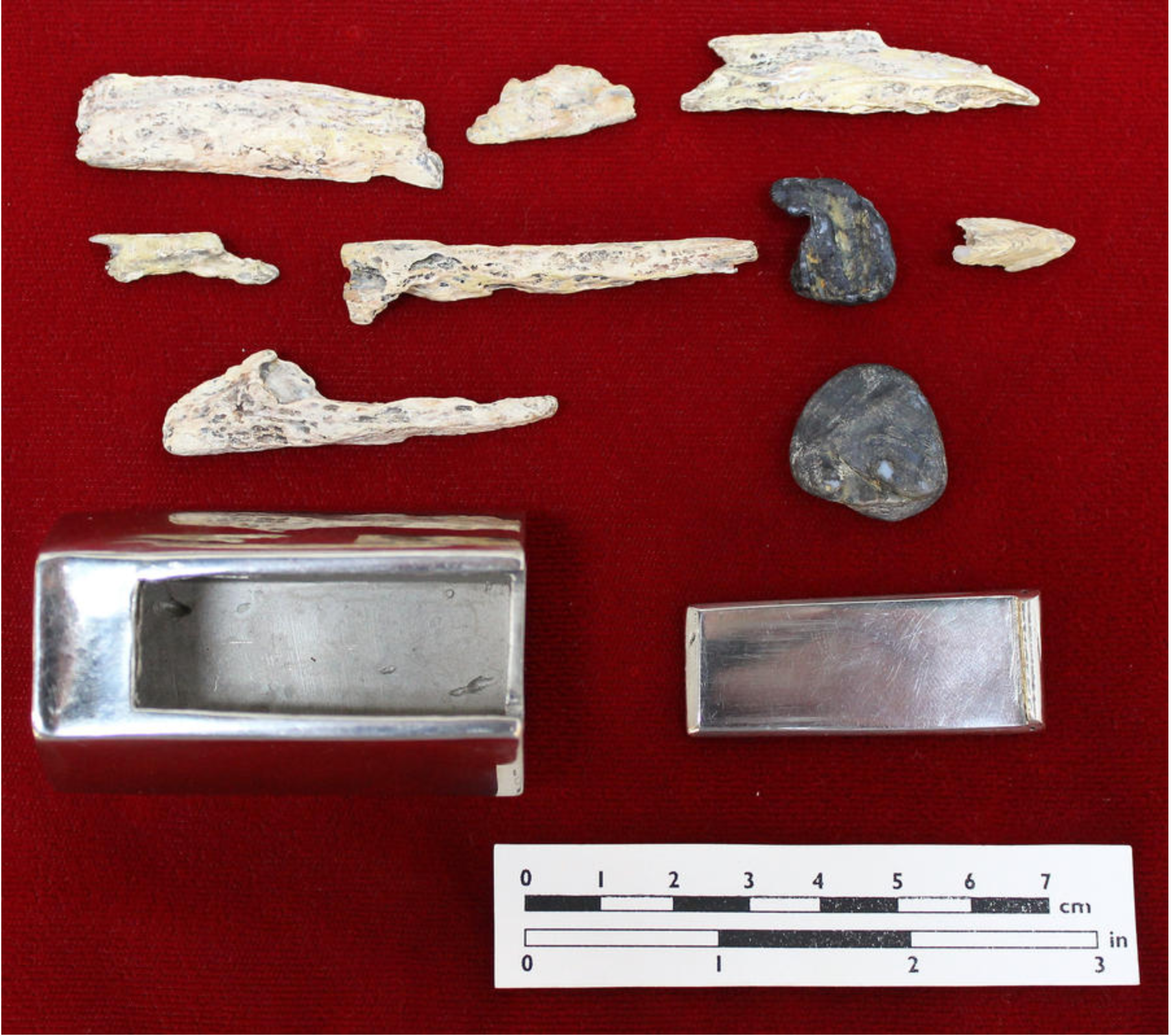
-reproductions of Jamestown, VA reliquary (1609/10) and contents
Relics of Mayne’s body survive. A portion of his skull is in the Carmelite Convent at Lanherne, Cornwall. Christopher M. B. Allison suggests that the silver reliquary discovered in 2015 at Jamestown, Virginia in the grave of Captain Gabriel Archer (died 1609/10) may contain a relic of Mayne.
Litany of St Cuthbert Mayne, Priest & Martyr
Lord, have mercy. Christ, have mercy. Lord, have mercy.
Christ, hear us. Christ, graciously hear us.
God the Father of heaven, have mercy on us.
God the Son, Redeemer of the world, have mercy on us.
God the Holy Ghost, have mercy on us.
Holy Trinity, one God, have mercy on us.
Holy Mary, pray for us.
Queen of the English, pray for us.
Queen of Martyrs, pray for us.
Saint Cuthbert Mayne, pray for us.
Who wast of mild nature and sweet behaviour, pray for us.
Who didst repent of the trappings of false religion, pray for us.
Who didst at length embrace the True Faith, pray for us.
Who didst flee abroad to be priested, pray for us.
Who didst study for the priesthood at Douai, pray for us.
Who wast desirous as a priest to honour God, pray for us.
Who wast desirous to offer reparation for sin, pray for us.
Who wast inflamed with zeal to save souls, pray for us.
Who wast sent in secret to England, pray for us.
Who didst labour in Cornwall, enduring danger and peril, pray for us.
Who didst reconcile so many to the Church, pray for us.
Who wast seized by evil men, pray for us.
Who wast cruelly imprisoned, pray for us.
Who wast wrongfully tried, pray for us.
Who wast unjustly convicted, pray for us.
Who didst refuse to swear the unlawful oath, pray for us.
Who wast condemned to death, pray for us.
Who didst pray so earnestly, pray for us.
Who wast illumined by a great light, pray for us.
Who wast hung, drawn, and quartered, pray for us.
Protomartyr of Launceston, pray for us.
Protomartyr of Douai, pray for us.
Protomartyr of Oxford, pray for us.
Protomartyr of the seminary priests, pray for us.
Of whose converts none ever recanted, pray for us.
Whose relics work miracles, pray for us.
Who dost reign with Christ for ever, pray for us.
All ye holy Martyrs of England and Wales, pray ye for us.
Be merciful, spare us, O Lord.
Be merciful, graciously hear us, O Lord.
From all evil, deliver us, O Lord.
From all sin, deliver us, O Lord.
From the snares of the devil, deliver us, O Lord.
From anger, and hatred, and all ill will, deliver us, O Lord.
From error, dissension, and division, deliver us, O Lord.
From heresy and schism, deliver us, O Lord.
From everlasting death, deliver us, O Lord.
By thine eternal priesthood, deliver us, O Lord.
By that ministry whereby thou didst glorify thy Father upon earth, deliver us, O Lord.
By thine institution of the most holy Eucharist, deliver us, O Lord.
By thy bloody immolation of thyself made once upon the cross, deliver us, O Lord.
By that same sacrifice daily renewed on the altar, deliver us, O Lord.
By that divine power, which thou, the one and invisible priest, dost exercise in thy priests, deliver us, O Lord.
By the triumph of thy grace in all thy holy martyrs, deliver us, O Lord.
We sinners, we beseech thee, hear us.
That thou wouldst deign to rule and preserve thy holy Church, we beseech thee, hear us.
That thou wouldst deign to preserve the Apostolic See, and all ecclesiastical orders, in holy religion, we beseech thee, hear us.
That thou wouldst deign to humble the enemies of holy Church, we beseech thee, hear us.
That thou wouldst deign to grant peace and unity to all Christian people, we beseech thee, hear us.
That thou wouldst deign to recall all the erring to the unity of the Church, and to lead all unbelievers to the light of the Gospel, we beseech thee, hear us.
That thou wouldst deign to send faithful and unshakeable workers into thy harvest, we beseech thee, hear us.
That thou wouldst deign to deliver us from all heresy, faithlessness, and blindness of heart, we beseech thee, hear us.
Son of God, we beseech thee, hear us.
Lamb of God, who takest away the sins of the world, spare us, O Lord.
Lamb of God, who takest away the sins of the world, graciously hear us, O Lord.
Lamb of God, who takest away the sins of the world, have mercy on us.
Christ, hear us. Christ, graciously hear us.
Lord, have mercy. Christ, have mercy. Lord, have mercy.
Our Father… (in secret until)
V/. And lead us not into temptation.
R/. But deliver us from evil.
Ant. Under the altar of God I heard the voice of the slain saying: Why dost thou not avenge our blood? And they received the divine response: Wait yet a little while, until the number of your brethren be fulfilled. (P.T. Alleluia.)
V/. What torments were suffered by all the saints.
R/. That they might securely come to the palm of martyrdom.
V/. The bodies of the saints are buried in peace.
R/. And their names shall live for evermore.
V/. Precious in the sight of the Lord.
R/. Is the death of his saints.
V/. The saints have entered the kingdom with palms.
R/. They have merited crowns of beauty from the hand of God.
V/. O ye Martyrs of the Lord, bless ye the Lord for ever.
R/. O ye choir of Martyrs, praise ye the Lord in the highest.
V/. Thee the white-robed army of Martyrs praise, O Lord.
R/. Thee the holy Church throughout the world doth confess.
V/. Make us to be numbered with thy saints.
R/. In glory everlasting.
V/. O Lord, hear my prayer.
R/. And let my cry come unto thee.
Let us pray.
O God, who didst grant to blessed Cuthbert before the other seminary priests to run the road of torments for the salvation of souls: grant to us in thy mercy, that inflamed with the same zeal for souls, we may not hesitate to lay down our lives for others.
Increase in us, O Lord, faith in the resurrection, who dost work wonders by the relics of thy Saints: and make us partakers of that immortal glory, a pledge of which we venerate in their ashes.
Stir up in us, O Lord, the Spirit that the blessed Martyrs of Douai obeyed: that being filled with the same, we may study to love what they loved, and to do the works that they taught.
O God, who didst strengthen thy blessed Martyrs Cuthbert and his companions with unconquerable courage, that they might fight for the true faith and the primacy of the Apostolic See: by hearkening unto their prayers, we beseech thee to help our frailty, that, strong in faith, we may be able to resist the enemy even to the end.
O God, who didst raise up thy blessed Martyrs Bishop John, Thomas, and their companions from every walk of life to be champions of the true faith and of the Supreme Pontiff: by their merits and prayers, grant that, by profession of the same faith, all may be made and remain one, as thine own Son prayed.
We beseech thee, O Lord, mercifully to receive the prayers of thy Church: that, all adversities and errors being destroyed, she may serve thee in secure freedom.
O God, who dost correct those who have erred, and dost gather those who were scatttered, and dost preserve those who have been gathered together: we beseech thee, clemently pour forth upon Christian people the grace of union with thee, that, rejecting division, and joining themselves to the true shepherd of thy Church, they may be able to worthily serve thee. Through our Lord Jesus Christ thy Son, who with thee liveth and reigneth in the unity of the Holy Ghost, God, world without end.
R/. Amen.
V/. O Lord, hear my prayer.
R/. And let my cry come unto thee.
V/. By the intercession of blessed Cuthbert, may almighty God bless us, the Father, and the Son, and the Holy Ghost.
R/. Amen.
V/. And may the souls of the faithful departed, through the mercy of God, rest in peace.
R/. Amen.
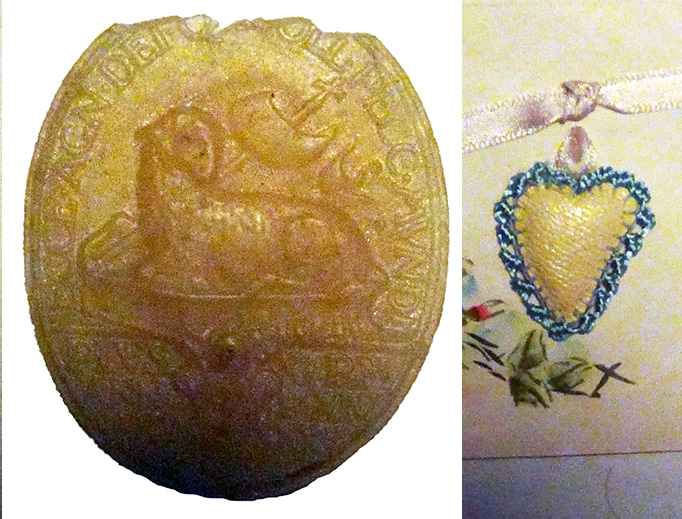
-Agnus Dei discs from the collection of Gary Minella, Queens, New York. The wording on the disc on the left reads: “ECCE AGN DEI … PECC . MUNDI” and “PIUS XI PM … ANNO P XIV MCMXXXV”.
Agnus Dei sacramental
The Agnus Dei is an ancient sacramental―a sacred object, or action, which the believer uses for the purpose of obtaining spiritual favors through the Church’s intercession. It might possibly be the Church’s oldest sacramental. There are historical accounts as to their existence even as far back as the sixth century. However, most people these days are completely unaware of them. In fact, some of the brightest theological minds in the Church have never even seen an Agnus Dei.
The Agnus Dei, whose name means “Lamb of God,” is a blessed wax disc impressed with the figure of the Lamb of God. But just as the St. Benedict Medal is not merely blessed but also exorcised, so too is the Agnus Dei consecrated rather than merely blessed by a reigning pope.
Traditionally Agnus Deis are consecrated only during the first year of a pope’s pontificate, and then again every seven years.
They are either round or oval. The lamb depicted upon them usually bears a cross or a flag. It’s not uncommon that images of saints or the name and arms of the consecrating pope are embossed on the reverse. This sacramental may be worn suspended around the neck or preserved as an object of devotion.
Centuries ago, popes would consecrate these sacramentals on Holy Saturday. They were made of the reworked wax from the previous year’s Paschal candles, to which chrism and balsam was added. Later, the Agnus Deis were consecrated on the Wednesday of Easter week and distributed on the Saturday of the same week.
In recent centuries, the task of preparing them was given to monks and nuns who would similarly collect the previous year’s Paschal candles. Cardinals visiting the pope would be given a disk to mark their visit. The cardinals would then in turn place them in their miter—probably because they didn’t have pockets back then. The Cardinals would then distribute the Agnus Deis to those in need of them.
The sacramental is rich in symbolism, mostly from the Old Testament. As in the Paschal candle, the wax symbolizes the virgin flesh of Christ. This is because medieval people believed that the bee was the only animal that reproduced without the benefit of sexual congress—thus, the fruit of their bodies, the wax, was produced “virginally.”
The lamb bearing a cross embossed on the disk is to remind the Christian of the Mosaic sacrifice in which a lamb was offered to God as an expiation of sins. The lamb’s shed blood would then protect Jewish households from the destroying angel (Exodus 12:1-28). Thus, the Agnus Dei emulates and reflects this blessing protecting the bearer from all malign influences. The prayers used in preparing the wax medallions make special mention of protection against storms, pestilence, fire, floods, and the dangers to which women are exposed during pregnancy and childbirth. In fact, several miracles have been attributed to these sacramentals including extinguished fires and stayed floods. In fact, Pope St. Pius V, fearing that the rising Tiber would flood Rome, threw an Agnus Dei into the river which immediately subsided.
In their writings, Popes Urban V, Paul II, Julius III, Sixtus V and Benedict XIV specifically mention some of the special virtues attributed to the Agnus Dei:
- foster piety, banish tepidity, deliver from temptation, preserve from vice, preserve from eternal ruin and dispose to virtue.
- cancel venial sins and purify from the stain left by grievous sin after it has been remitted in the Sacrament of Penance.
- protection against sudden and spiritually unprovided death. (i.e., securing a happy death)
- banish evil spirits.
- dispel fears occasioned by evil spirits.
- protection in combat, and the power to ensure victory.
- protection against poison
- protection against the snares of the wicked.
- protection against false accusations.
- protection against illness and an efficacious remedy against illnesses.
- protection against the ravages of pestilence, epidemics and infectious diseases.
- protection against bouts of epilepsy.
- protection for mothers and babies against peril and provide for a safe and easy delivery.
- protection against shipwrecks.
- protection against lightning and floods.
- protection against hailstorms, tempests, tornados, lightning and hurricanes which are circumvented or dispelled.
- that at the sight or touch of the Lamb impressed on these waxen discs, the faithful should be inspired to dwell on the Mysteries of our Redemption recalled by this symbol, be moved to praise, venerate, and extol God’s goodness to us, hoping to obtain pardon for their sins, and to be cleansed from all stain of sin.
- protection against poison and its effects.
- through Divine Intervention, protection against the snares, wiles and frauds of Satan which should not prevail.
Like all sacramentals, this object serves to remind us of God and His place in our lives. It reminds us to serve Him and love our neighbor. It’s absolutely not a charm or talisman to bring “good luck” or repel evil, as that would be blasphemy. The medal has no intrinsic “magic ability.” (It should be pointed out that all power in the universe is in God’s hands and doesn’t reside elsewhere. In other words, people who claim to have magic powers are deluded or lying.)
To be clear, the Agnus Dei has no power in and of itself. It is, after all, only so much wax. To act as if it’s magical is sacrilege and assuredly the best way to make sure you don’t receive its spiritual benefits. Rather, its graces and favors are due to our faith in Jesus Christ, Our Redeemer, to the efficacious prayers of the pope who consecrated it (James 5:16) and to the abundant blessings which the Church has bestowed upon those who wear and pray with the sacramental.
This sacramental is highly esteemed by the Church and it’s often given to those who are spiritually afflicted or harassed. Considering their holiness and their inherent rarity, limited to the amount of wax salvaged from the previous year’s Paschal candles collected in the churches of Rome, Agnus Deis were greatly cherished by the faithful and passed down from generation to generation. Apparently, they caused so much fear and consternation among the enemies of the Church that Catholic-bashing Queen Elizabeth I of England outlawed their importation into her realm, calling them “popish trumperies.”
Though the origins of the Agnus Dei are lost to history, it’s most likely a Christian substitute for unenlightened pagan charms and amulets. It’s not impossible to think that the Agnus Dei was meant to ween pagans from their peculiar demons and bring them into the Light of Christ. Thus, instead of believing in sympathetic magic somehow “inherent” in their amulets, they were given the Agnus Dei to save them from themselves. If such is the case, we can comfortably trace the origins of the Agnus Dei back to the fifth century, in which we can say that Rome was finally made a Christian city.
From the time of Amalarius (c. 820) onwards we find frequent mention of the use of Agnus Deis. Popes often gave them as presents to monarchs and other distinguished personages. This first historical mention of this particular sacramental describes them as having been made from the previous year’s Paschal candles. Ennoldius (c. 510) specifically mentions that the fragments of the Paschal candles were used as a protection against tempests and blight.
The earliest examples of an Agnus Dei still in existence come from the reign of Pope Gregory XI (AD 1370).
After the shards of the Paschal candles are harvested from Rome’s churches, melted and poured into forms, they are given to the pope and he dips them in water which had been blessed and mingled with balsam and chrism. At that, the Holy Father prays over them, asking God to impart to all those who are given the Agnus Deis true faith and sincere piety.
Once the cardinal or bishop was given an Agnus Dei, they in turn either gave it as a present to someone or, more likely, broke off small pieces of the wax disk so as to make sure as many people as possible could benefit from it. The small piece of wax was then kept in a locket or other suitable container.
Inexplicably, the practice of consecrating the Agnus Dei sacramental was abandoned following the Second Vatican Council. The last pope to consecrate them was Pope Pius XII (r. 1939-1958), who created them in 1945 and 1952.
Perhaps, one day, the Church will reinstitute this beautiful custom. Or perhaps she won’t. Either way, we can still be assured of the pope’s prayers for us, his spiritual children—and, of course, the blessings of Christ and His Mother and, indeed, all the angels and saints. As Christians, we don’t believe in magic. In fact, we have something by far better―salvation.
A papal bull had to be issued several centuries ago warning the Faithful not to buy these sacramental—not because of simony, which is a horrible sin in and of itself—but rather because those being sold were most likely forgeries. Do not procure them from the internet, despite the claims people make there.
A prayer for those who carry or wear an Agnus Dei
Jesus, my Savior, true Lamb of God, Who takest away the sins of the world, by Thine infinite mercy, I beseech Thee to pardon my iniquities. By Thy sacred Passion, I beseech Thee, preserve me this day from sin and shield me from all evil. To Thine honor and glory, I carry about with me this blessed Agnus Dei as a protection to my soul and body, and as an incentive to practice the virtues which Thou hast inculcated, especially meekness, humility, purity and charity.
In memory of that sacrifice of love which Thou didst offer for me and all mankind on Calvary, I consecrate my whole being to Thee. Thou didst die on the cross for love of me; let me die to self for love of Thee! Keep me in Thy love and Thy grace to the end of my life, that I may bless Thee forever with the saints to Heaven. Amen.
The “Agnus Dei” disc dates to the 5th century and was made from the wax of the Paschal candle.
Sacramentals have been part of the Catholic Church in various ways from the very beginning. They are known as extensions of the seven sacraments and naturally flow from them.
Broadly speaking, sacramentals can be any number of actions or blessings that the Church has instituted over the years. The Catechism of the Catholic Church explains how sacramental blessings can be invoked over “persons, meals, objects, and places” (CCC 1671). These blessings call down God’s grace upon a particular individual or object and ask for lasting spiritual protection.
One object of the Church that is among the oldest known sacramentals is the “Agnus Dei” disc. This is a disc of wax with the figure of a lamb impressed upon it. Historically these discs were worn around the neck and were made from the previous year’s Paschal candle. They were originally created on Holy Saturday morning and distributed to the people on the following Saturday.
The tradition dates to around the 5th century, and later the pope was more intimately involved with the sacramental. It became a reserved blessing of the pope, who consecrated these pieces of wax during the first year of his pontificate and every seven years after that. It is believed that Pope Pius XII was the last reigning pontiff to bestow such a blessing.
The sacred wax was a constant reminder of Christ’s Easter victory. According to various papal writings, those who wore it were instructed, “that at the sight or touch of the Lamb impressed on these waxen discs, the faithful should be inspired to dwell on the Mysteries of our Redemption recalled by this symbol, be moved to praise, venerate, and extol God’s goodness to us, hoping to obtain pardon for their sins, and to be cleansed from all stain of sin.”
Below is a prayer for those who wear an Angus Dei sacramental that summarizes the spiritual disposition that the piece of wax was supposed to cultivate in the person wearing it. The prayer can still help us today to meditate on that saving action of the Passion, death and resurrection of Jesus and how that event should influence our lives.
My Lord Jesus Christ, the true Lamb who takest away the sins of the world, by thy mercy, which is infinite, pardon my iniquities, and by thy Sacred Passion preserve me this day from all sin and evil. I carry about me this holy Agnus Dei in thy honor, as a preventative against my own weakness, and as an incentive to the practice of that meekness, humility, and innocence which Thou hast taught us. I offer myself up to Thee as an entire oblation, and in memory of that sacrifice of love which Thou didst offer for me on the cross, and in satisfaction for my sins. Accept this oblation, I beseech Thee, O my God, and may it be acceptable to Thee in the odor of sweetness. Amen.
Some historians place the origin of the Agnus Dei as early as the time of the Emperor Constantine, near the beginning of the 4th century. The discovery of the Agnus Dei in the tomb of the pious Empress Maria Augusta is the strongest evidence of the antiquity of it’s introduction among Christians.
The Catholic dictionary placed the beginning of the custom as early as the time of Pope Zosimus, who ascended the throne of Peter in the year 417. When the Pascal candle was finally extinguished on Ascension Day the people were accustomed to procure small portions of what was left of it and carry them home as a protection against tempests. All authors agree that it was from this custom of the people that the Agnus Dei had it’s origin.
Love & truth,
Matthew

